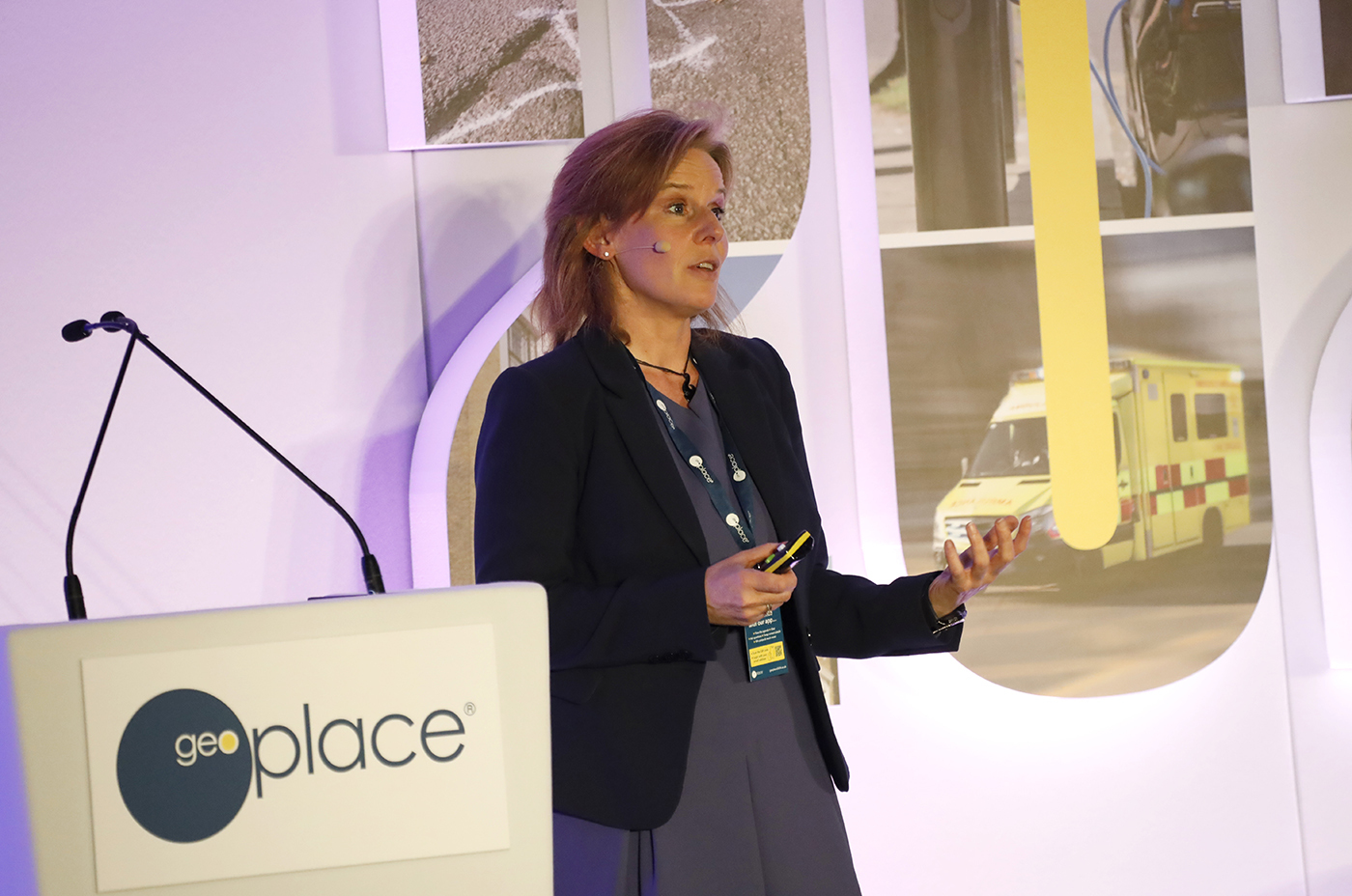SPEAKERS:
- Nick Chapallaz, CEO, GeoPlace
- Tom Treadwell, Senior Strategy Advisor Dept. of Levelling Up Housing and Communities (DLUHC)
- Beth Rudolf, Director of Delivery at the Conveyancing Association and Deputy Chair of the Home Buying and Selling Group (HBSG)
Recordings of the 2024 conference talks can be found here
Welcome to the GeoPlace Conference 2024
Nick Chapallaz opened the GeoPlace 2024 conference by welcoming more than 400 delegates to the event. He started by outlining the event’s objectives, exploring the theme of ‘connecting people and places’. This is a priceless, consistent and constant ambition - not only for GeoPlace, but also for society. This conference brings the experts together: meeting, learning and sharing ways in which location data can transform society. The GeoPlace Awards reflect progress, and in some ways act as benchmarks in the delivery of our vision and mission. It involves the whole of the custodian and data provider community - there are many other data providers, but together we have enormous potential to help others make more of our national data assets.

In a world in which everyone benefits in the value of that data - of the highest quality data - we're committed to innovating and transforming people's lives. If we're in government, that means citizens. If we're in the commercial sector, that means customers. UPRNs and USRNs sit at the heart of society, connecting processes and delivering through systems out into the market.
Nick iterated: "When data is at the heart of an organisation, we can be best served for the long term, regardless of what's happening with systems. In the last year, over 21 million changes have been made to the data we hold at GeoPlace, through an end-to-end lifecycle of collection, curation, quality control and management. At the heart of it all are the UPRN and USRN - enabling organisation to ask a single question and find multiple answers, all built on a foundation of truth. Our data bring accuracy and certainty. Precision and effectiveness, and efficiencies for everyone. Add intelligence - artificial or otherwise - and innovation, and there's no limit to what can be achieved."
The Government's view on buying and selling
Tom Treadwell set the scene by noting that on average it takes 21 weeks to complete a house purchase: a time period that has been increasing in recent years. Since 2007, the length of time between instructing a conveyancer and reaching completion has increased by 39 days. A second issue is that far too many transactions fall through before they reach completion - about one in three. Many fall through because people become nervous, their circumstances change, or they change their mind about the property. But some stakeholders highlight that if customers could be sure their transactions were going to complete, and their expectations were managed at the beginning of the process, that would go a long way to improving things.

"It is imperative that transactions speed up and increase their certainty," said Tom: "It's not just consumers who face issues under the current system. There are consequences for industry too. Estate agents and conveyancers lose around 4 million working days and a billion pounds each year as a result of failed transactions."
There are numerous reasons for this situation. A major problem, however, is a lack of proper upfront property information. Secondly, far too much takes place offline. Digitalisation is the key - enabling UPRNs to unlock real value from within the property chain. Consumer awareness is still a factor, but the home buying and selling industry itself presents challenges. It is an ecosystem of professionals, with around 15 different organisations involved in every transaction. All of those organisations currently work to their own requirements, often using systems that aren't as interoperable as they might be. This means inefficiencies are multiplied, and we don't see information exchanged between professionals as seamlessly as might be possible.
Norway provides an example of how the UK might address this situation. It has undertaken a huge digitalisation process, digitalising their system end-to-end. All property information is in a trustworthy digital format, with data and connectivity standards enabling information to be shared between the different parties that are involved in a transaction. Property information is easily gathered up front in a trustworthy digital format, so buyers know exactly what they're getting when they start a transaction.
That makes the job of conveyancing much easier. It is often possible to move home in Norway in as little as four weeks, and the reforms are expected to deliver savings to the Norwegian economy of around 10 billion pounds over the course of 10 years.
Australia is another good example: property is most often purchased through a single online digital platform that acts as a one-stop shop for consumers and property professionals. Everyone can check on the status of their transactions and look up information from a single platform at any point.
The benefit of that system is that property transaction fall-throughs are something like a third of those in the UK - only about one in ten transactions fail before they reach completion. Again, it is common to move house in Australia in as little as four weeks.
The government's Levelling-Up White Paper addresses this. The aim is to ensure buyers have access to the information they need in a trusted digital format. Projects are ongoing around the three pillars of empowering consumers, opening up data, and delivering a digital service to try and deliver on that commitment. Local land charge data is being digitised and put on a single national local land charges register, and Open Data pilots are taking place: the focus is on data captured by CON29.
Recent funding should also support further development of data and connectivity standards, making it easier for property information to be shared between professionals involved in home buying and selling. PropTech innovation pilots will be set up, specifically focused on home buying and selling, and it is hoped that the development of digital tools will have a significant impact on the home buying and selling process. The government has also endorsed UPRNs as a data standard through the Data Standards Authority - and work is now ongoing to support the wider rollout of UPRNs across the home buying and selling system.
Please note, this presentation is a reflection of the policy of the 2019-2024 Government.
Digitalising the Home Moving Process
As Co-Chair of the Home Buying and Selling Group (HB&SG) and Director of Delivery at the Conveyancing Association, Beth Rudolf addressed the conference. The HB&SG is a 150 strong set of participants that come together across all of the sectors in the home moving process: estate agents, mortgage brokers, mortgage lenders, through to removal companies and also the regulators and representative bodies; all come together to collaborate, to identify what the problems are and what can be done to solve them.

Beth put the situation into context: the reason for buying or selling a property is usually due to a death, a debt, divorce, a child on the way, or change of job. This means stakeholders are already stressed, the economic stasis of a 22-week-period can be debilitating. The situation has improved, however, over the last couple of decades, not always in a linear fashion.
In 2002, for example, the Land Registry 'electrified' its register and at the same time, dematerialised deeds as an authoritative instrument. That meant lawyers could no longer charge the cost of a fireproof safe to store the deeds packets. But it also meant lenders welcoming the opportunity to de-commission warehouses full of deeds. However, deeds were all sent back to clients, who didn't realise how important they were - and in many cases, lost them or at least did not find them until they were packing to move on the day of Completion. Progress, however, is happening.
In 2023, material information guidance was published by National Trading Standards. The Residential Property Logbook Association was created - digital logbooks that replace a deeds package, enable consumers to interact with their property during its life cycle. Not just owners but also landlords, and potentially tenants, too. To enable that information to be digitalised it is imperative that provenance is authenticated. Here, the Open Property Data Association has huge value.
"The Open Property Data Association has identified and created the Property Data Trust Framework that enables data authentication and interoperability," said Beth. "Having information early enables information to be reviewed efficiently, particularly in light of the Consumer Protection from Unfair Trading Regulations, which state what should be declared in property advertisements."
Looking to the future, the Digital Property Market Steering Group is focused on improving interoperability even further: ensuring the provenance of data can be relied upon to make sure it is FAIR data - findable, accessible, interoperable and reusable. Public data sets need to be released, to make the process more efficient. And consumer education is key.
In particular, the UPRN holds immense value for the property chain, in many different ways. In building safety, for example, there is a real issue that a landlord certificate and the leaseholder deed of certificate are not registered. But when a UPRN is attached to them - a conveyancer, a landlord, and a property manager can all have confidence in whether or not it is a qualifying lease.
Identity standards are also important; cyber and property fraud protection plays a role and the UPRN can be attached to the SDLT form, as well (although at the moment this is optional). "What we need is improved compliance, which leads to more efficiency," said Beth. "We can increase Land Registry efficiency using the UPRN, enabling stakeholders to identify which properties all sit within the same estate, for example, using parent and child and sibling relationships. And by doing that, we can enable professionals to eliminate backlogs, too."
If you would like to be involved in the Digital Property Information Protocol and the Data Supply element of the DPSMG, please do get in contact with the Home Buying and Selling Group.
You can download this write up as a PDF here.



